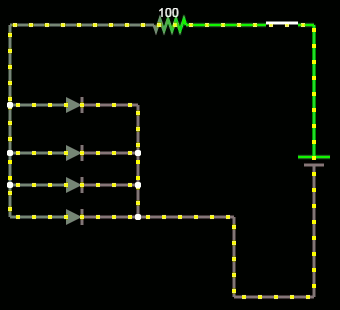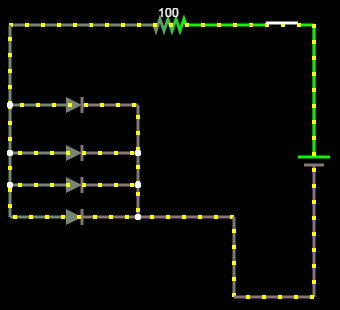While writing an answer about using multiple diodes connected to a single resistor, I stumbled upon a case about which I haven't read a lot: What happens when we set the resistor so that it sets the current to be within safe levels for a single diode and then connect several diodes in parallel to it?
The LEDs themselves should be safe from overload, becasue the current is limited. I expect that in the LED case, the distribution of current among them will not be equal since those with lower initial forward voltage will get more current and will be brighter. After a while the forward voltages will match and the current distribution will stay uneven.
Is there anything else that will happen? I've read the answers in this question and some of them mention oscillations, but don't elaborate on the topic.


Best Answer
No harm will be done, but this result will seldom be useful.
One possible use is for eg a backlight where you only need as much light as one LED would make but you want it more widely distributed physically than you can achieve with only one LED. I have actually done this BUT it is an unusual application.
The forward voltages will match instantaneously "by definition" and will stay matched as they are connected together electrically. What WILL vary is common Vf and the current that each LED takes. The LED that takes the most current will heat the most (subject to absence of differing ventillation and heatsinking etc). With 10 LEDs the effect of variable individual cooling could have a significant effect on results.
For practical purposes the LEDs will settle down with currents about equal to the currents that they initially drew at the group Vf. See "Oscillations?:" below for comment on why the result is somewhat more complex in reality - BUT that you will not notice this.
The above are the main things that will happen.
Luminous efficiency increases slightly with decreasing current. ie if you run 1 LED at x mA or 2 LEDs at x/2 mA each you will get slightly more light from the two LEDs.
Lifetime to say 70% of initial output will increase significantly if you share X mA among 2 LEDs and very very very much so if you share it amongst 10 LEDs.
This is based both on the current density per LED and the likely reduced die temperature. These are largely independent effects.
OSCILLATIONS? : As shown in the typical graph below, the effect of increasing temperature is to slightly decrease the forward voltage for a given current, As Vf is common to all LEDs this will instead have the effect of slightly lowering the overall group VF and of increasing the share that this LED takes.
As an LEDs VF/current curve is not linear this will not "run away" indefinitely but will assume a new higher current value. Other LEDS may then have very slightly less current so cool somewhat so draw less current so decrease group Vf so decrease net current so ... . This is the "oscillation that is referred to in the post you mentioned by Rocket Surgeon and it is a real effect but it will essentially always be such a small effect that you will not notice formal oscillation - just a very small continual shift of overall operating point.